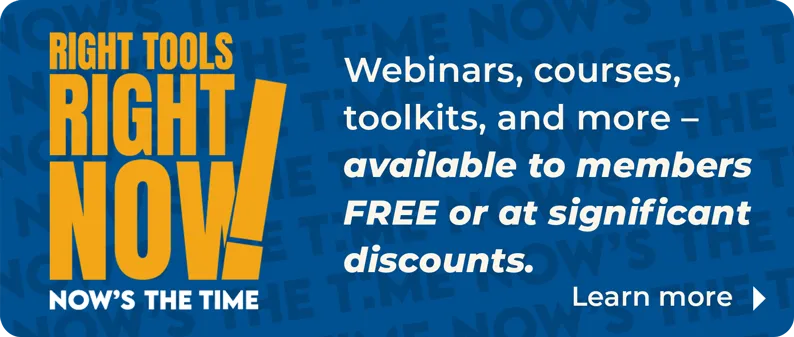Chances are, your association budget, like so many others’, got a little fat during the real estate boom years. Soaring memberships filled reserves and funded a range of new programs and services. But now, in the midst of a market correction in many areas, some associations find now is the time to prepare a leaner budget.
Of course what you can, or should, trim from your budget is unique to your association and your local market conditions. You must gauge your members’ needs and expectations by conducting research and surveys, and then do some number crunching. Also, foster discussion among staff and leadership and remember that outside consultants can bring much-needed objectivity to the tough task of trimming the fat. Here are some tips and tricks for saving, cutting, and doing more with less.
1. Reduce “small” spending
When finances are fat, the hundreds of small purchases associations make often go unchecked. For example, office supply spending nudges up, as does the quality and volume of food delivery for meetings and staff parties. Although you never want to cut the little things that make a big difference to members and employees—like the free office coffee—now’s the time to take a closer look at how all that small spending adds up.
Installing vending machines for sodas and snacks, rather than simply providing them for class attendees, is one small way association executive Tori Chriestenson, RCE, is saving and generating a little revenue at the Montrose Association of REALTORS®.
2. Reward staff for finding ways to save
Make your staff participants in, not victims of, cost cutting by fostering a “we’re all in this together” attitude. First and foremost, keep staff in the loop about budget issues to keep anxiety down. Hold a contest for coming up with the most creative and effective money-saving ideas.
3. Renegotiate contracts
Try to negotiate lower fees and better terms in your vendor and service provider contracts—this includes everything from equipment maintenance to leases. If you’re not in a long-term contract with certain service providers, such as Web site hosts or printers, shop around for better deals.
Brandie Miner, communications director at the Georgia Association of REALTORS®, was able to shave more than $40,000 a year from her printing budget by seeking a new print vendor.
“With the economic downturn, I knew it was time to take a close look to see where we could save money,” says Miner. “The most obvious target was my department’s biggest expense, the Georgia REALTOR® magazine.” However, since advertising in the magazine is a major revenue stream for GAR, Miner needed to save money without sacrificing the magazine’s quality.
By hiring a consultant to send out a request for proposals to several printing companies, Miner found a less expensive printer in Wisconsin who will also improve the magazine’s quality.
4. Cut energy, utility costs
Turning computers, printers, and fax machines off at night, installing motion sensor lights, and switching to energy-efficient bulbs can take a chunk out of your monthly utility costs.
Additionally, ceiling fans can reduce the perceived air temperature by 10 degrees at one-tenth the cost of air-conditioning. Fans aren’t just for summer, either. In the winter, reversible ceiling fans help heat your office by pushing warmer air lower without creating an uncomfortable draft.
5. Scale down events
Just because times are lean doesn’t mean you can’t have any fun. Instead of canceling big-ticket social or networking events, try scaling them down. For example, try a potluck buffet for the holiday party instead of catering. For higher profile events, you might ask a restaurant to sponsor the occasion. In exchange for catering the affair, you could offer them co-branding with the association on all promotional materials.
6. Hire free help
Contact local colleges or universities to find interns to help with projects or daily tasks for school credit. Business and technology majors along with students in communications and marketing can help with projects ranging from producing events, upgrading technology, and developing promotions or publications.
7. Lease, don’t buy
Rather than lay out thousands of dollars—or more—on new computers, printers, and the like, rent technology equipment for a more manageable monthly payment. There are annual tax benefits to leasing and, depending on your lease; you’ll save on upgrades and maintenance in the long run.
8. Sell unused items
Take stock of your office. Chances are, you have some unused equipment, furniture, fixtures, or file cabinets to sell. Post them on eBay, Craigslist or, better yet, hold a garage sale together with members who, likewise, need to generate cash. The event can build solidarity among members and bring in a surprising amount of revenue.
9. Seek new partnerships
The mortgage and home inspection companies that used to be your best event and program sponsors are probably cutting their budgets, too. Open your affiliate membership category to a broader range of professionals, keeping in mind that affinity partnerships are foremost to meet the needs of the membership. Partner with other associations on classes and events to boost attendance and lower costs. For a long list of ways to partner with neighboring associations, visit nar.realtor, search: “Field Guide to Association Shared Services.”
10. Reevaluate your facilities
Is now the time to refinance your office-building mortgage or renegotiate your lease? If you’re leasing your building, you may be able to cut overhead costs by talking with your landlord or property manager. Sometimes you can lower your monthly rent by extending your lease. If you’re locked into your lease, consider subleasing some space or renting out your classrooms or boardrooms. If moving is an option, transitioning to a smaller space within the building may also be a cost-effective solution.
11. Expand or add services
To save your bottom line, think beyond cuts to launching new revenue generators. Boost enrollment or expand offerings of your most successful programs and services, such as training or technology offerings. Sell staff expertise and time to members, especially your technical staff. Also, consider renting office space or equipment usage to members or others in your community. Fee-for-service business support centers can be a way to scale down membership-wide programs into services just for the members willing to pay extra for them.
12. Print to Online?
Switching from a print to an online member magazine can save a tremendous amount of money in printing and postage. Yet, as Alison Martinsen, the public relations and marketing director of the Santa Clara County Association of REALTORS®, Calif., found, getting rid of a print newsletter could end up costing the association more.
“A cutback on communications tools will most likely affect our members’ use of our services, therefore, reduce revenue, and in the long run, weaken our ties with members,” says Martinsen, who presented her leadership with numbers to back up her theory.
Santa Clara has 7,800 members and on average less than 12 percent who receive the online version of the association’s newsletter open it. In addition to the low open rate, more than a thousand members chose not to receive electronic mail and in June 712 e-mails bounced back. So according to Martinsen’s calculations, 6,110 members did not read the June newsletter.
This study backs Martinsen’s member survey data that shows members prefer to read a print newsletter.
To cut costs of the print publication, Martinsen is negotiating with the post office to reduce the postage rate to periodical class, which would save 17 cents a copy. “Combined with the discount we have negotiated with our mail house from 15 cents to 7 cents per copy, we would cut the costs of the hardcopy from $42,000 to $20,000 a year,” she says.
“At a time of declining membership, we need to strengthen our communications with our members,” says Martinsen. “The communications tools we provides are perhaps the most important way to stay in touch with members and remind them of the benefits that we offer.”
“We were thrilled to find a way to cut costs and keep producing our popular print publications,” says association CEO Gene Binsbachar.
What not to cut:
Image campaign
Newspaper advertisements and television and radio spots are expensive, but now may be the worst time to cut your image and publicity campaigns for several reasons. First, they are one of the most visible ways members see what you do for them, and second, after years of establishing a presence in your community as the voice for real estate, you don’t want to lose that momentum; simply change your message to “now’s a great time to buy” or focus on local market conditions. For help recrafting your message, tap into NAR’s Surround Sound campaign resources for examples from other REALTOR® associations, how tos, talking points, and more; www.nar.realtor/press_room/surroundsound
Beloved events
Social events like the office or member holiday party, or the charity food drive, hold a special place in members’ hearts. Before eliminating these favorites, try scaling down and shifting some of the costs to participants.
To cut staff?
John Fridlington, CEO of the Florida Association of REALTORS®, is a strong advocate of staff and worries about them becoming pawns in today’s budget decisions. Calling staff “the most important asset of the association,” he says staff are currently at their most vulnerable, and more than ever, they should be shown appreciation, not the door. “CEOs should step up to the plate to make that point,” he says.
However, John Graham, CEO of the American Society of Association Executives, says sometimes the only short-term solution to creating a budget when revenue is falling is eliminating staff positions since they are the most prevalent driver on the expense side. “The problem is most organizations’ staff is 35 to 40 percent of their costs,” he notes. “It is the only place you can cut that is meaningful to the bottom line.” Most of the association CEOs and CFOs around the country are doing just that, but fortunately, mostly through attrition.








